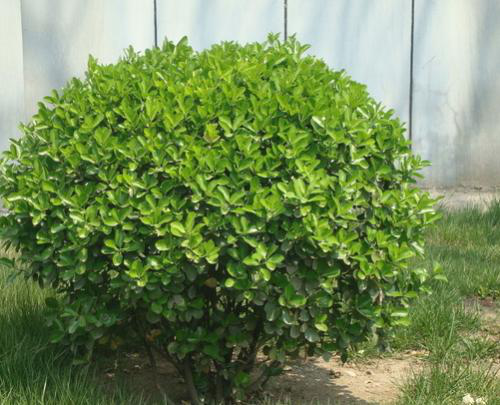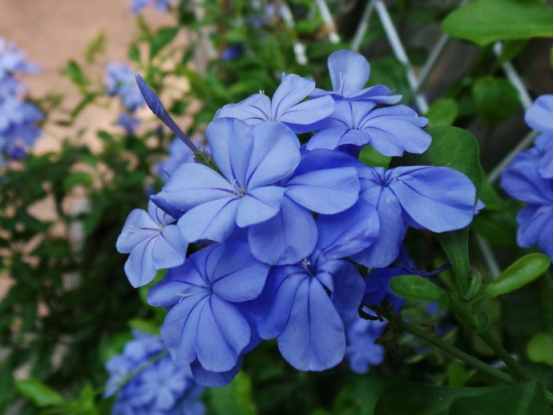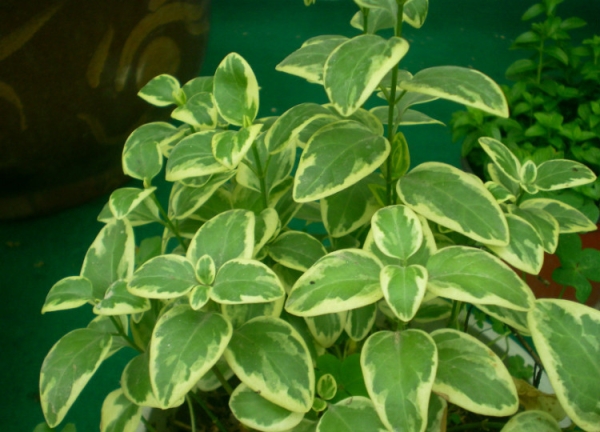Introduction to the culture method of privet
1. Container
Privet is a large shrub, so when raising privet potted plants, try to choose larger flowerpots, purple sand pots or pottery flowerpots, it is best to choose according to the shape of privet, suitable flowerpots can make privet and containers more complementary.
2. Basin soil
Ligustrum lucidum has developed root system, strong growth adaptability, and can adapt to all kinds of soil. as long as the soil is loose, fertile and rich in humus, it can meet the normal growth of privet.
3. Watering
During the growing period of privet, you should water more and keep enough water, because privet likes moist growth environment, watering should be fully watered, and the periphery of the basin should be kept moist. Lack will lead to privet branches and leaves atrophy, withered and yellow, seriously affecting the ornamental.

4. Fertilization
Privet in the basin, to apply some basic fertilizer, in the growing period needs to apply thin fertilizer, in the spring and autumn season, each applied twice cake water fertilizer, to provide adequate nutrition for privet growth and promote growth.
5. Lighting
Privet likes light, so usually you should choose balcony or outdoor sunny places, but remember not to shine directly, give privet proper shade in order to have more green burst.
OK, the above is the introduction of the daily breeding methods of privet. Next, let's take a look at the matters that we need to pay attention to in the process of privet culture.
Culture method of privet
1. Seed collection: Ligustrum lucidum blossoms from April to May, seeds mature from November to December, the pericarp is black when it is ripe, it should be harvested at the right time, and the fruit does not fall off itself after ripening. Cut the ear with high branches, stroke the fruit, soak the fruit, rub off the pericarp, wash it and dry it in the shade. If the seeds are not sown immediately, they can be bagged and stored dry or mixed with 2 parts of wet sand and 1 part of seeds.
2. Raising seedlings: Ligustrum lucidum can be raised by sowing and cutting, and it is more common to sow and raise seedlings. Sowing seedlings from early March to mid-April. The soil of the nursery is not strict, as long as it is loose and fertile. Before sowing, soak the peeled seeds in warm water for 1 to 2 days, then sow, strip sow or sow. The row spacing of strip sowing is 20 cm, the covering soil is 1.5 cm ~ 2 cm, and the sowing amount per mu is about 7 kg. Because the emergence time of privet seedlings is longer, about 1 month, it is best to cover grass on the border to preserve soil moisture after sowing. After the seedlings are unearthed, they should loosen the soil and weed in time, and carry out inter-seedlings when the seedling is 5 centimeters high. the seedlings are afraid of waterlogging and should pay attention to drainage, but they should also be irrigated in case of excessive drought and fertilized for 1 or 2 times according to routine management. Weed once a month. The height of one-year-old seedlings can reach 50 cm. If large seedlings are cultivated, they need to be planted in another bed and come out of the nursery after 2 ~ 4 years.
Culture methods and matters needing attention of privet
Latin name Ligustrum lucidum Ait.
Also known as ash tree, holly, wax tree, Nu Zhen, Zhen wood, general tree
The plant kingdom.
Phylum angiosperm
Dicotyledonous class
Subclass synpetalous flower
A transitional flower order.
Suborder Oleacea
Oleaceae
Subfamily Oleaceae
Rhinoceros olive tribe
Ligustrum lucidum
Planting privet
Distributed in China, Korea, Japan, Linshan and valleys
English name Chinese Glossy Privet
Privet (scientific name: Ligustrum lucidum), also known as holly, is an evergreen shrub or tree of the genus Ligustrum lucidum of Oleaceae, up to 25 meters high, with grayish brown bark. Branches yellowish brown, gray or purplish red, Terete, sparsely orbicular or oblong lenticels. Ligustrum lucidum is a subtropical tree species with dense branches and leaves and neat tree shape. it is a commonly used ornamental tree species, which can be planted alone or in clusters in the courtyard, street trees, hedges and so on. Ligustrum lucidum is native to China and widely distributed in the Yangtze River basin and the south. It is also cultivated in North and Northwest China. It can withstand the low temperature of about-10 ℃. It is a widely used native tree species in landscaping. Mainly distributed in Jiangsu and Zhejiang, Jiangxi, Anhui, Shandong, Sichuan and Guizhou, Lianghu, Liangguang, Fujian and other places. The method of sowing, cutting and striping was used to propagate. Leaves can be distilled to extract holly oil, which is used as an additive for sweets and toothpaste. Mature fruit sun-dried for the traditional Chinese medicine Ligustrum lucidum, cool, sweet and bitter taste, but clear eyes, black hair, tonifying the liver and kidney.
1. Morphological characteristics.
Leaf blade evergreen, leathery, ovate, long-ovate or elliptic to broadly elliptic, 6-17 cm long and 3-8 cm wide, apex acute to acuminate or obtuse, base rounded or subrounded, sometimes broadly cuneate or attenuate, leaf margin flat, shiny above, both surfaces glabrous, midvein concave above, raised below, lateral veins 4-9 pairs, slightly raised or sometimes obscure on both surfaces; petiole 1-3 cm long, sulcate above, glabrous. Panicle terminal, 8-20 cm long and 8-25 cm wide; peduncle 0-3 cm long; inflorescence rachis and branched rachis glabrous, purple or yellowish brown, fruit angled; basal bracts of inflorescence often homomorphic to leaves, bracteoles lanceolate or linear, 0.5-6 cm long, 0.2-1.5 cm wide, withered; flowers sessile or subsessile, not more than 1 mm long; calyx glabrous, 1.5 mm long, teeth obscure or subtruncate. Corolla 4-5 mm long, Corolla tube 1.5-3 mm long, lobes 2-2.5 mm long, reflexed: filaments 1.5-3 mm long, anthers oblong, 1-1.5 mm long; style 1.5-2 mm long, stigma clavate.
Fruit reniform or subreniform, 7 × 10 mm long, 4 × 6 mm in diameter, dark blue-black, red-black at maturity, whitish pink; fruiting pedicel 0-5 mm long. The florescence is from May to July and the fruiting period is from July to May of the following year.
2. Growth habits
Ligustrum lucidum has good cold resistance, moisture resistance, warm and humid climate, light and shade tolerance. It is a deep-rooted tree species with well-developed fibrous roots, fast growth, strong sprouting ability, resistance to pruning, but not resistant to barren. It has strong resistance to air pollution, strong resistance to sulfur dioxide, chlorine, hydrogen fluoride and lead vapor, and can tolerate high dust and smoke pollution. The requirement of soil is not strict, it is suitable to be cultivated in sandy loam or clayey loam, and it can also grow in red and yellow loam. Born in sparse and dense forests below 2900 meters above sea level. It can withstand the low temperature of-12 ℃, but it is suitable for planting in humid, leeward and sunny places, especially in deep, fertile and humus-rich soils. Privet is very sensitive to highly toxic mercury vapor, once smoked, leaves, stems, Corolla, pedicels and young buds will turn brown or black, and in severe cases will lose leaves and buds. Privet can also absorb highly toxic hydrogen fluoride, sulfur dioxide and chlorine.
3. Distribution of producing area
Produced in the south of the Yangtze River to South China, southwest provinces, to the northwest to Shaanxi, Gansu. It is also distributed in North Korea and cultivated in India and Nepal.
4. Cultivation techniques
Breeding and sowing chooses loam, sandy loam and light clay with leeward and sunny, fertile soil, convenient drainage and irrigation, deep tillage layer as sowing. After the application of base fertilizer, intensive ploughing and harrowing, so that the upper and lower solid, land leveling. Manure is the main base fertilizer, and more application of base fertilizer is beneficial to improve soil temperature and maintain soil moisture. Causes the seeds to absorb water and germinate. Mix well with 50% phoxim EC 6.0~7.5L/hm2 and fine soil 45kg, evenly withdraw to the surface before ploughing, bury it in the soil to eliminate underground pests, and flatten the bed.
The seeds of Ligustrum lucidum are mature from November to December. After the seeds are mature, they are often covered with waxy white powder, so they should be harvested in time, and the trees with strong strength, good posture and strong resistance should be selected as the mother trees. You can cut the ear with high branches, stroke the fruit, soak it in water for 5 to 7 days, rub the peel off, wash it and dry in the shade. Two parts of wet sand and one part of seeds can be stored in wet storage from the end of March to the beginning of April. Soak the seeds in hot water, soak them out and wet them for 4 to 5 days before sowing.
Winter sowing is carried out before freezing, and generally there is no need for budding. Spring sowing is carried out after thawing, and budding has a significant effect. In order to break the dormancy of privet seeds, the seeds were soaked in 550mg/kg gibberellin solution for 48 hours before sowing, the water was changed once a day, and then taken out to dry. After 3-5 days of storage, the buds were immersed in water for 25-30 ℃, and the water was changed every day. Sowing seedlings were sown from the first and middle of March to April. The peeled seeds were soaked in warm water for 1 day before sowing. The row spacing of strip sowing was 20cm and the soil was covered with thick 1.5~2.0cm. The sowing rate is about 105kg/hm2. Ligustrum lucidum emerged for a long time, about 1 month. After sowing, it is best to cover the border with grass to preserve soil moisture.
After the field management seedlings are unearthed, the seedlings should be loosened and weeded in time, and the seedlings should be carried out. According to the conventional management, the height of one-year-old seedlings can reach 50cm. Ligustrum lucidum is a wet plant, but too much water can easily lead to disease. Water must be strictly controlled and water should be sprayed every day to meet the needs of privet growth environment. Water spraying can be carried out by sprinkler irrigation facilities, which can not only ensure the area of water distribution, maintain the ground humidity, but also reasonably control the amount of water. The best time to spray water should be 8, 00, 10, 00, or 16, 00, 18, 00, every day. Xiaomiao is afraid of waterlogging and should pay attention to drainage. Privet does not need much fertilizer to grow at the seedling stage. As long as foliar fertilizer is applied properly, water-soluble chemical fertilizer can be selected and sprayed with water 2kg per 5g. The best time is to spray the leaves completely for 1 time, which is the best time to spray the leaves at 1600 / 18 / 00. It can be done once every 15 days.
When the light is very strong. Sunshade net should be used to avoid high temperature caused by strong light and affect the growth rate of seedlings. Weeding is usually done once a month. Be careful when weeding to avoid harming the roots of the plant. At seedling stage, plants are vulnerable to aphids. For aphids, prevention is the main way. Omethoate 800x solution can be used to spray the aphids. The time can be chosen at 8: 00, 10: 00 or 16:00, and the standard is to spray the leaves completely once.
Transplanting pruning one is transplanting pruning. When transplanting in the nursery, the trunk should be cut short. Under the cut, only one strong bud can be selected to develop into a trunk extension branch, while the other bud opposite to it must be removed. In order to prevent the formation of top competitive branches, the first and second pairs of buds under the cut should be destroyed at the same time. The second is planting and pruning. Before planting, the annual extension branch of the central trunk of the large seedling should be truncated by 1 beat 3, the cutting buds should be strong and strong, and 1 bud in the first pair of buds under the cutting mouth should be removed. In order to ensure the advantage of bud tip selection. In order to prevent the formation of competitive branches at the top, the second to third pairs of axillary buds under the cut should be destroyed. For the other branches located in the lower and middle part of the central trunk, 3 or 4 main branches with certain spacing and scattered distribution should be selected. Each main branch should be short, leave the bud, peel off the bud, in order to expand the crown, keep the crown ventilated and transparent. The rest of the thin and weak branches can be released slowly without pruning to support the growth of the trunk. Summer pruning is mainly to cut short the competitive branches on the central trunk, constantly weaken its growth potential, and cut off the sprouting branches on the trunk and roots at the same time. In the second year of winter cutting, it is still necessary to cut short the central trunk and extend the branches. But the direction of budding is opposite to that of the first year. If a competitive branch occurs in the upper part of the central trunk, it should be retracted or truncated in time to weaken the growth potential.
Diseases and insect pests include rust and blight. 5. Main value
Garden use Ligustrum lucidum is whirling in four seasons, with sparse branches, dense branches and leaves, and neat tree shape. it is a commonly used ornamental tree species in the garden, which can be planted alone or in clusters in the courtyard, as well as street trees. Because of its strong adaptability, fast growth and resistance to pruning, it is also used as a hedge. Generally, it can be formed after 3 to 4 years, and the isolation effect can be achieved. It is easy to sow, propagate and raise seedlings, and it can also be used as a rootstock to propagate sweet-scented osmanthus, cloves and colored leaf plant Ligustrum lucidum.
Medicinal value Ligustrum lucidum fruit medicinal, harvest mature fruit sun-dried or hot water after drying, traditional Chinese medicine known as Ligustrum lucidum. Cold, sweet and bitter. It has the effect of nourishing liver and kidney, strengthening waist and knees, black beard and eyesight. It is used for symptoms such as vertigo and tinnitus, sore waist and knees, early white hair, dark eyes, tinnitus and deafness, early white hair and loose teeth.
After 24 hours of impregnation, Ligustrum lucidum leaves can be distilled to extract fragrant holly oil, which is often added to sweets and toothpaste. Holly oil is easily absorbed by the skin, it has convergence, diuresis, excitement and other effects, can be used to treat muscle pain.
- Prev

Matters needing attention in culturing Lanhuadan
Blue snowflakes are born on hillsides and on the ground. They like warmth and are not resistant to cold. In North China and other temperate regions, they can be cultivated as flowers with a suitable temperature of 25 ℃ and light, but they should not be exposed to the hot sun. In summer, they should pay attention to proper shade and require a moist environment. Drying is disadvantageous to their growth and is not resistant to drought.
- Next

The solution to yellow leaves
Supplementary light flowers and leaves evergreen vine love light, only sufficient sunshine, growth will flourish. Pay attention to the soil. Choose the soil that the vine likes. The loose sandy soil with good porosity will meet its growth needs and will not cause yellow leaves. Control watering. Strictly control watering.
Related
- Fuxing push coffee new agricultural production and marketing class: lack of small-scale processing plants
- Jujube rice field leisure farm deep ploughing Yilan for five years to create a space for organic food and play
- Nongyu Farm-A trial of organic papaya for brave women with advanced technology
- Four points for attention in the prevention and control of diseases and insect pests of edible fungi
- How to add nutrient solution to Edible Fungi
- Is there any good way to control edible fungus mites?
- Open Inoculation Technology of Edible Fungi
- Is there any clever way to use fertilizer for edible fungus in winter?
- What agents are used to kill the pathogens of edible fungi in the mushroom shed?
- Rapid drying of Edible Fungi

